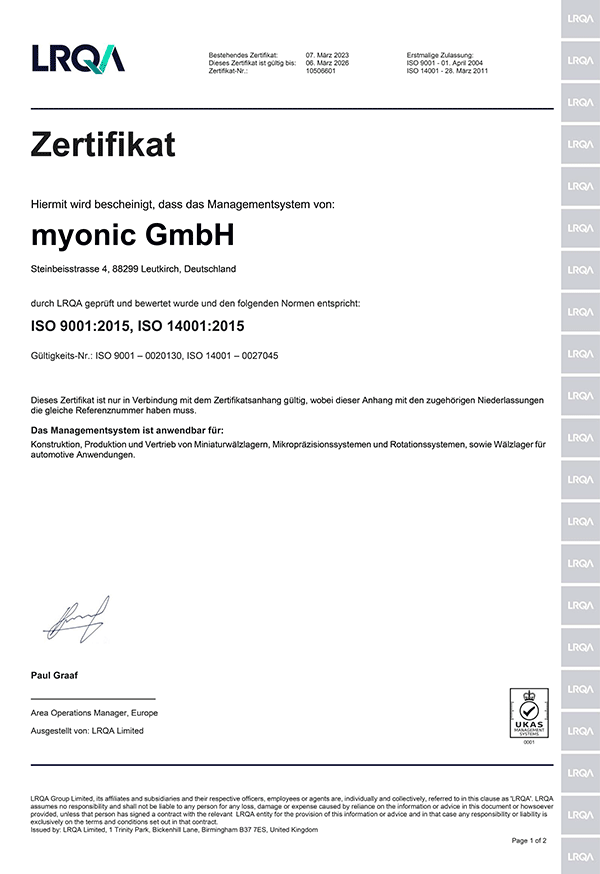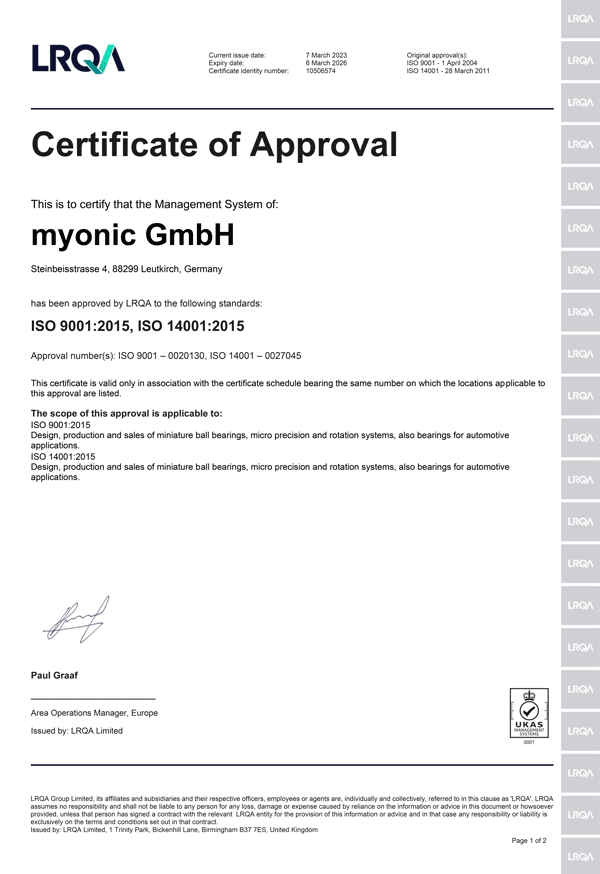myonic designation system for ball bearings
|
Basic designation |
Material |
One-Sided Closure |
Duplex Bearing |
Cage |
Tolerance Class |
Radial Clearance |
|
UL 3006 |
■ |
|
|
-48 |
-A5P |
-6/10 |
|
ULKZ 4008 |
■ |
.1c |
|
|
-A7P |
– |
|
RKF 310 |
■ |
.1v |
|
|
-P5P |
-11/20 |
|
R 6190 |
■ |
|
|
-237HG |
-P4P |
-2/5 |
|
ULKU 8012 |
■ |
|
|
-48 |
-A9P |
-2/10 |
|
RA 4012 |
■ |
|
|
-257HP |
-A7P |
|
|
R 5160 |
■ |
|
.9d/1000 |
|
|
-16/20 |
|
Types Example:
UL = design
3006 = Nominal dimension
of the bearing bore and outside diameter in 1/32 inch
or, for metric series, in millimetres |
X = 1.4125
(AISI 440 C) stainless steel |
.1 = one-sided closure
.1c = one-sided closure on the flange side
.1v = one-sided closure on the side opposite the flange
|
Arrangement type / preload
.9f = X arrangement
.9d = O-arrangement
.9t = Tandem arrangement
1000 = Preload of 10 N
|
Cage design,
number
of balls,
and cage material |
Dimensional and running accuracy
according to ISO or
ABEC |
Lower / upper
Limit in μm.
The standard
radial clearance is 6/15. |
|
|
See also: Material for ball bearing rings |
See also: Closures |
See also: Preload and duplex installation |
See also: Ball cages |
See also: Tolerance class |
See also: Bearing clearance and contact angle |
|
Basic designation |
Contact angle |
Noise |
Frictional torque |
Dimension group coding of inner and outer diameters |
Special instructions |
Lubrication |
|
UL 3006 |
|
|
10/75D |
-S2 |
-J... |
-L23 |
|
ULKZ 4008 |
|
|
|
|
|
-G48 |
|
RKF 310 |
|
-10/174 |
|
|
|
-G48/20 |
|
R 6190 |
|
|
|
-SB4/0C |
|
-G21/…mg |
|
ULKU 8012 |
|
|
|
|
-J... |
-L25 |
|
RA 4012 |
-20/25° |
|
|
|
|
-L23 |
|
R 5160 |
|
|
|
-S4/BB |
-J... |
-L23 |
Types Example:
UL = design
3006 = Nominal dimension of the bearing bore and outside diameter in 1/32 inch or, for metric series, in millimetres |
Lower / Upper
limit in degrees.
The standard
contact angle
is 17/22°. |
10 ≥ Limit value
174 = Measurement device
|
10 ≥ limit value in μNm
75 = Axial testing force in cN
D = Running friction moment
|
Classification
according to
dimension groups |
The letter J with
followed by an ordinal number
refers to
to internal company regulations
and denotes
requirements which
cannot be expressed by the previous suffixes. |
Letter code
L = Oil
G = Grease
Examples:
G5/20 = grease G5, 20% dispersion
G18/... mg = Grease G18 and dosage in mg
|
|
|
See also: Bearing clearance and contact angle |
|
See also: Friction |
See also: Group classification |
|
See also: Lubrication |
Cleanliness is crucial for the proper functioning of miniature ball bearings
myonic fulfills this requirement by:
Complete temperature and humidity control as well as air filtration in all production areas
Ultrasonic cleaning of components between the individual production steps
Cleaning the components using special processes developed by myonic immediately before assembly
Assembly of the ball bearings in clean rooms (ISO 7) under laminar flow boxes (ISO 5).
Strict adherence to cleanroom processes by all personnel working there
Cleaning of the fully assembled product using processes specially developed and optimized by myonic for miniature ball bearings
Use of special filtered lubricants
Packaging of the finished ball bearings in clean and hermetically sealed bags or tubes
This enables myonic to supply customers with ball bearings with the highest possible degree of cleanliness. In order to guarantee this condition until the ball bearing is installed, our customers should also exercise this high degree of care. We recommend that you observe the following instructions:
All adjacent components must be manufactured to the correct tolerances recommended in this catalog.
The surface quality of these parts must meet the requirements for the respective area of application and the components must be free of burrs, loose particles, swarf, rust, dirt, or similar.
Cleaning should be carried out outside the assembly area before final assembly, taking particular care to ensure that the cleaned parts are not soiled again during transportation to the assembly area.
The ball bearings should be installed in a specially equipped area that is separated from other rooms.
If possible, this area should meet the requirements for clean rooms and have a dust-free atmosphere as well as temperature and humidity control. Mechanical processing steps should not take place in the same room.
The installation personnel must comply with special cleanliness rules. Hand shoes and work suits such as coats and overcoats are usually used for this purpose.
Hoods made of special, lint-free material are used. Smoking, eating, wearing make-up etc. must be strictly prohibited in the cleanroom.
The miniature ball bearings should only be removed from the protective packaging immediately before installation. If a package contains more than one ball bearing, do not remove more than the immediately required number of ball bearings.
Ball bearings should be handled with tweezers or other special tools. High-precision miniature ball bearings must never be touched directly with fingers. We recommend wearing lint and abrasion-free finger cots or gloves.
The higher the demands placed on the bearings, the more important it is to strictly adhere to these recommendations.
myonic certifications
ISO9001/2015-ISO14001:2015
German (PDF 1,4MB)
DOWNLOAD
English (PDF 1,4MB)
DOWNLOAD
Czech (PDF 1,4MB)
DOWNLOAD
Material for Ball Bearing Races
With miniature ball bearings, the right choice of material is crucial for optimum function in the end application.
At myonic, materials are procured, tested and approved for use in products according to defined processes. The materials therefore meet the requirements for safe functioning of the end product.
myonic uses different types of steel to meet customer-specific requirements. Please contact the engineers in our sales and technical departments.
They will be happy to help you select the right material for your specific application.
Other materials are available on request.
|
Suffix |
Short name |
Availability |
Standard |
Equivalent standards |
Corrosion resistant |
Smooth running |
Hardness |
|
DIN |
AISI |
AMS |
SAE |
|
X |
X105CrMo17 |
standard |
1.4125 |
440 C |
5618 |
|
very good |
good |
61 HRC |
|
XG |
X65Cr13 |
on request |
1.4037 |
420D |
|
|
good |
good |
60 HRC |
|
XA |
X30CrMoN15-1 |
on request |
1.4108 |
|
5898 |
|
excellent |
good |
> 58 HRC |
|
V |
100Cr6 |
on request |
1.3505 |
|
6444 |
52100 |
no |
very good |
62 HRC |
Standard material suffix “X”
X105CrMo17- DIN 1.4125 – AISI 440C
This is the standard material, which is mainly used in areas where corrosion resistance is important.
This steel has a high degree of corrosion resistance and due to the heat treatment, this material has a good hardness of 61 HRC.
Material on request Suffix “V”
100Cr6 – DIN 1.3505 – AISI 52100
This material is most frequently used for the production of ball bearings of all sizes. Its composition complies with the AISI 52100 standard and ensures a good, uniform microstructure with a hardness of 62 HRC after heat treatment.
Material on request Suffix “XG”
X65Cr13 – DIN 1.4037
myonic introduced this steel grade at the customer’s request and to round off the range of corrosion-resistant bearing steels.
Due to the low carbon content, the degree of hardness is lower compared to AISI 440C steel, but still sufficient for use in rolling bearings. Despite the relatively low chromium content of 13% (limit value for stainless steels), the requirement for corrosion resistance is easily met.
Material on request Suffix “XA”
X30CrMoN15-1 – DIN 1.4108
This stainless steel has a large proportion of nitrogen, which, together with the available carbon produces a grain structure in which carbon nitrides are contained in the form of homogeneously distributed microspheres. The chrome content ensures corrosion resistance.
This special microstructure results in improved macromechanical properties, particularly with regard to hot hardness, elasticity, flexural strength and elongation at break. The achievable hardness is lower compared to AISI 440C steel.
Please contact our application engineers, who will make suggestions for the steel grade that is best suited to your application. Our engineers will offer you the right solution for applications with the highest demands on ball bearings. Steel grades from the above list and/or special materials can be used.



